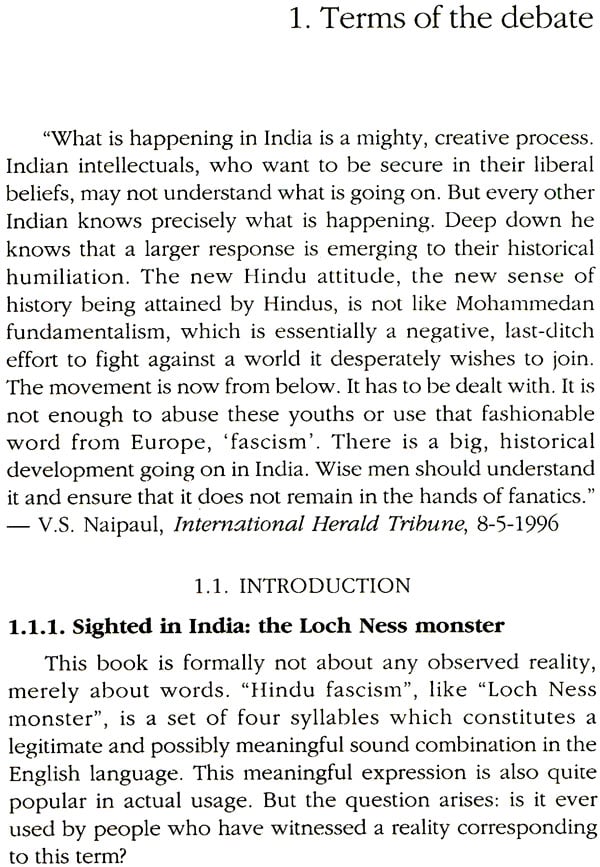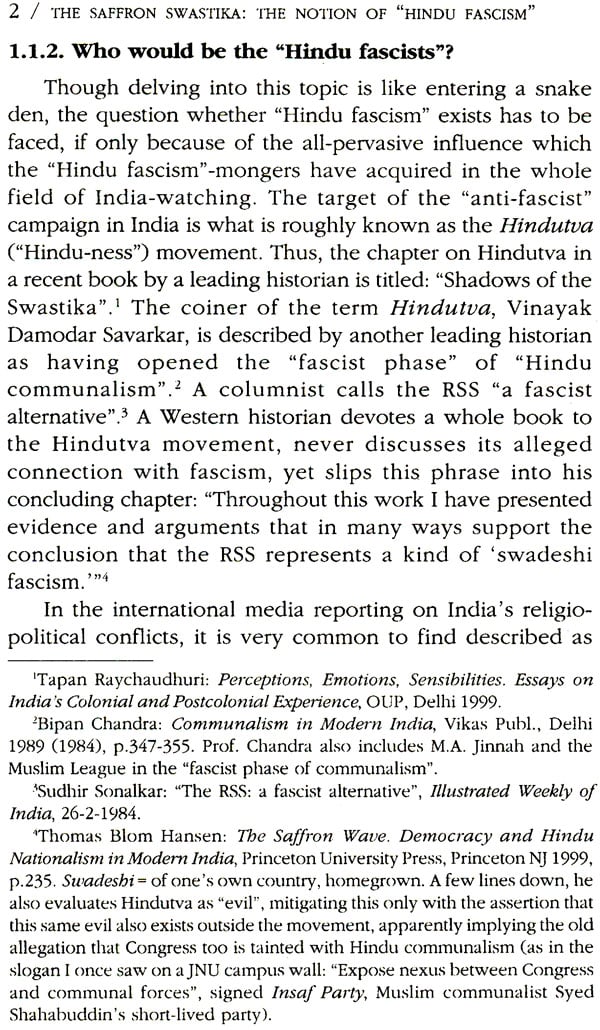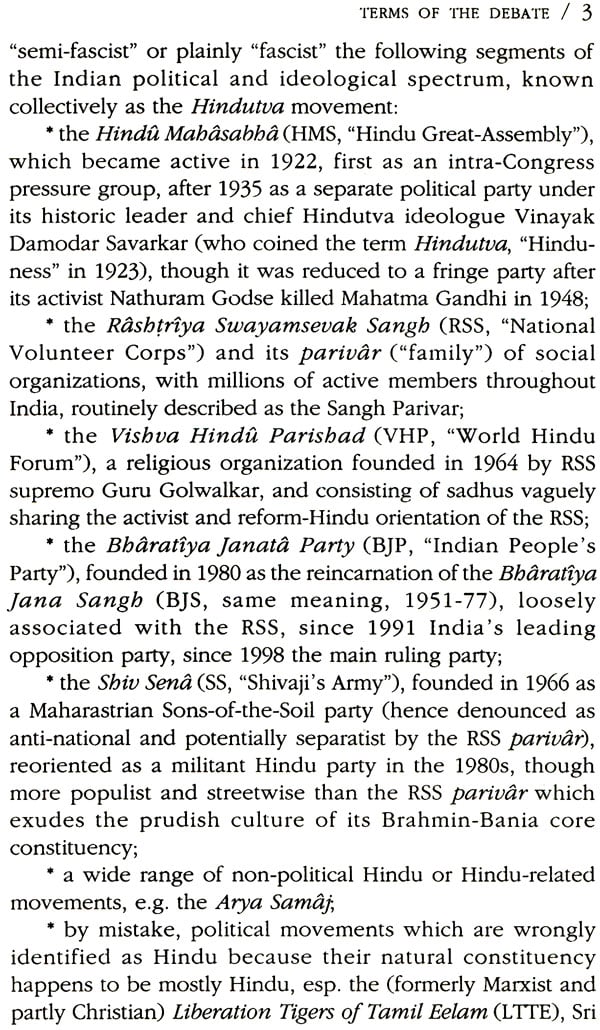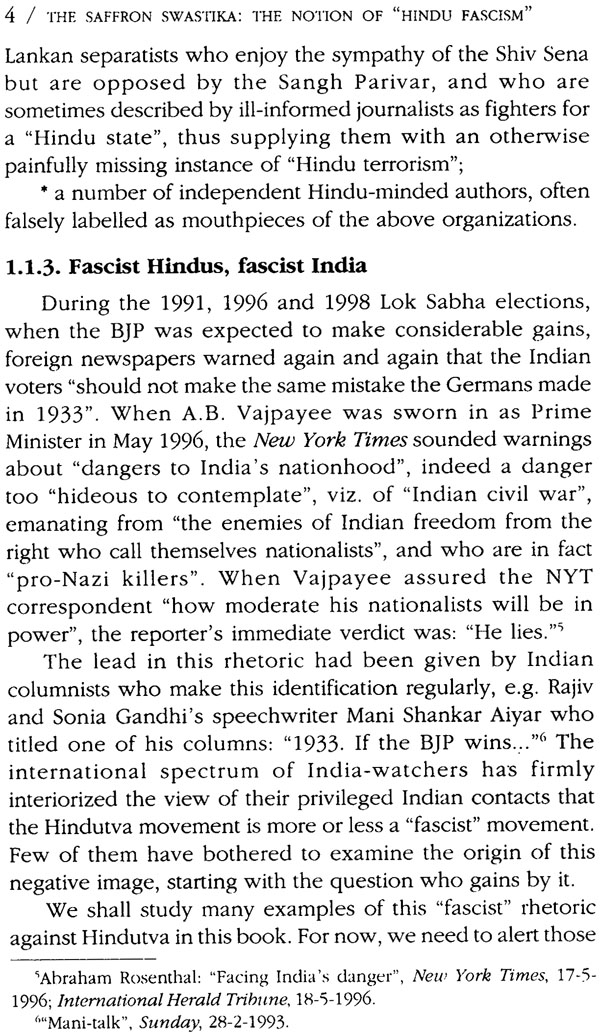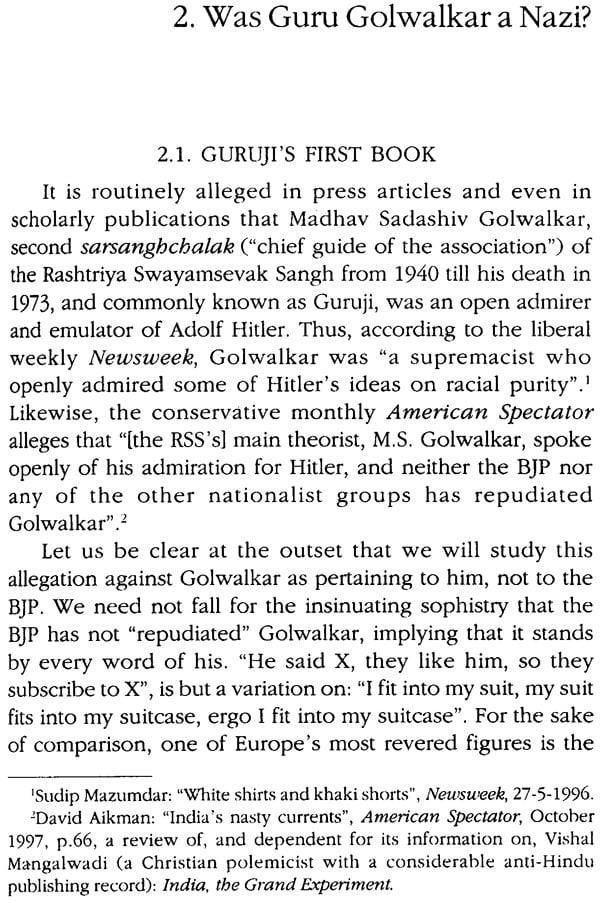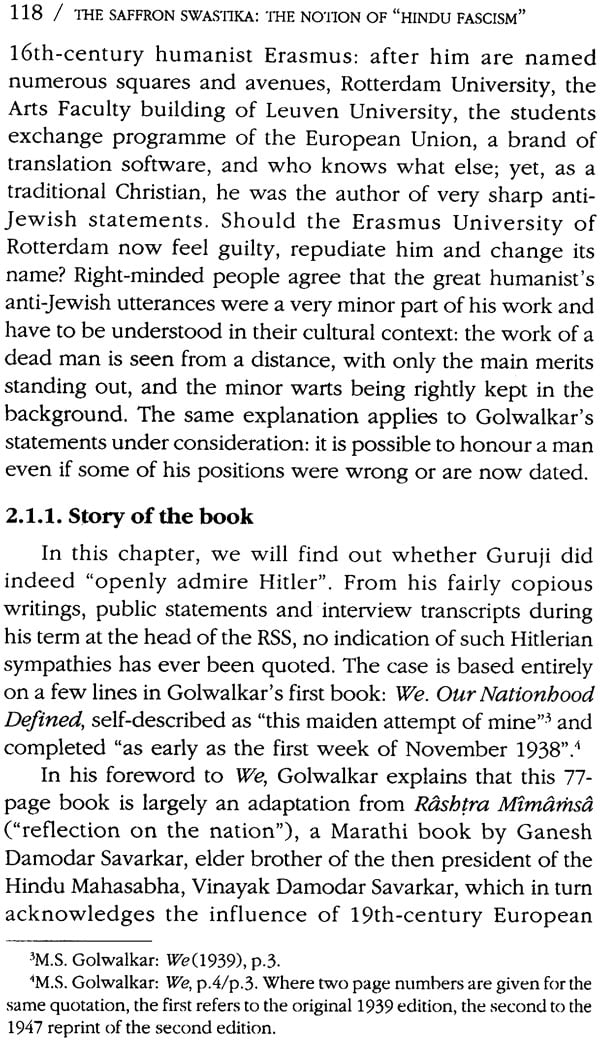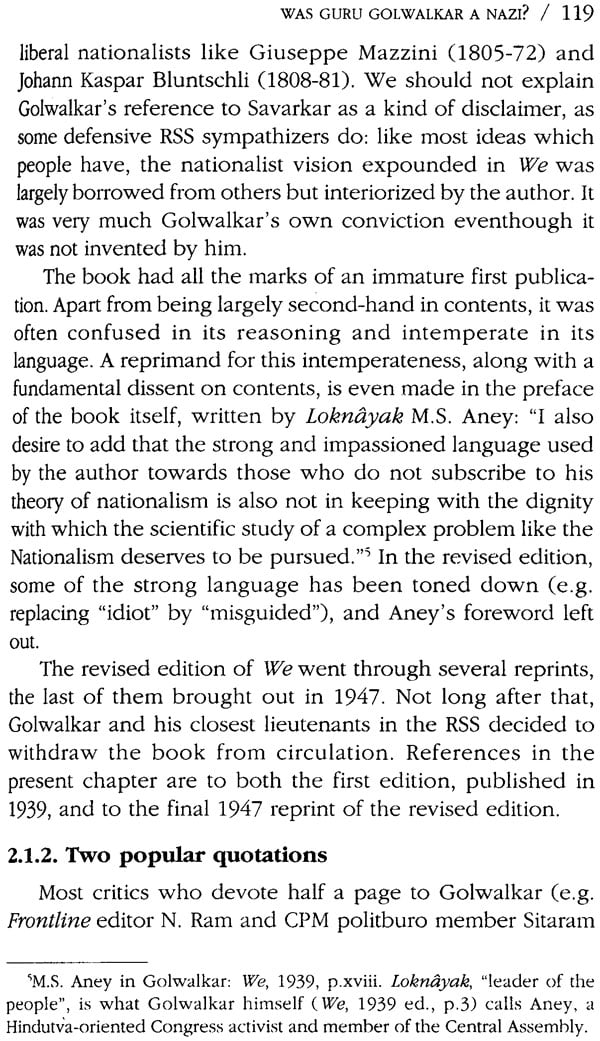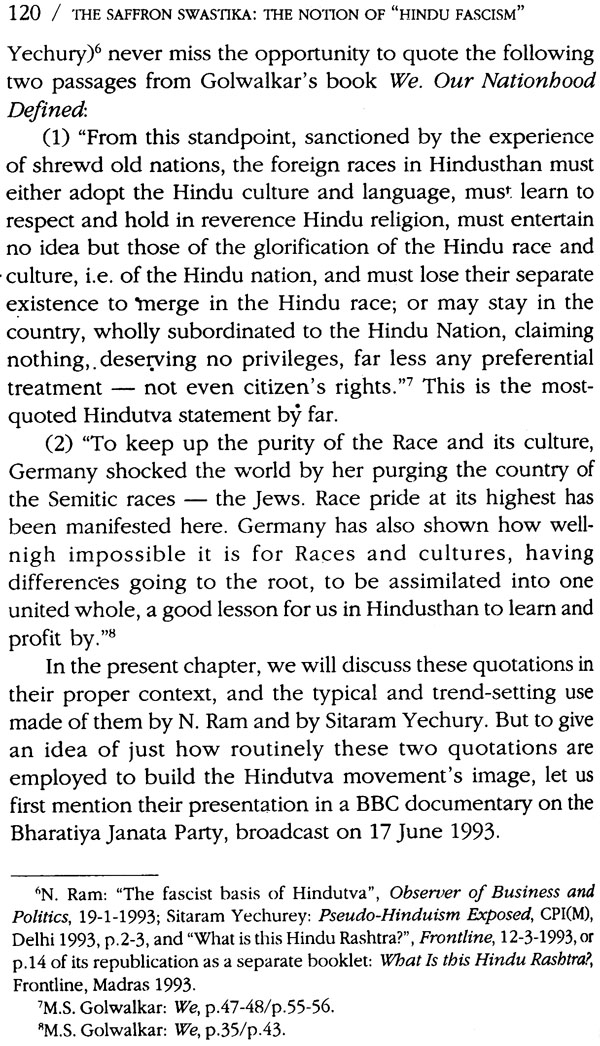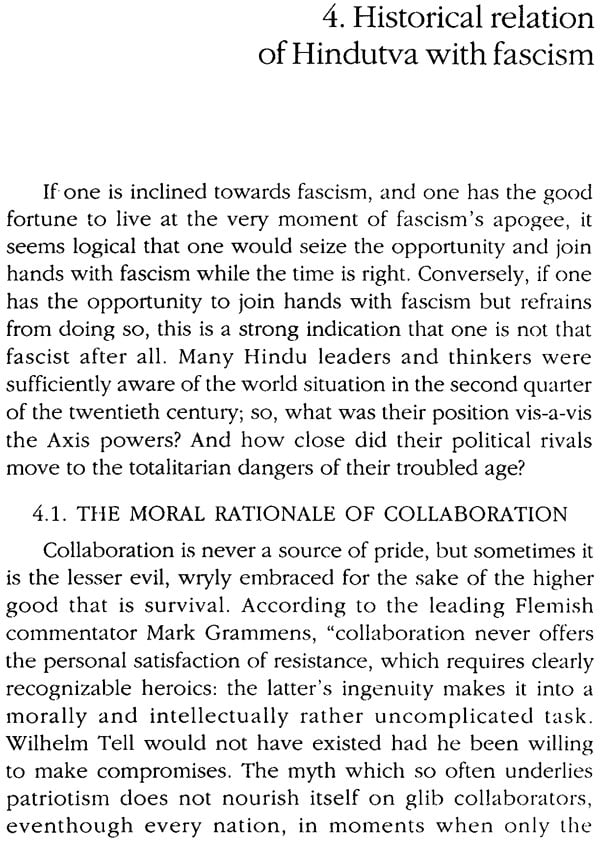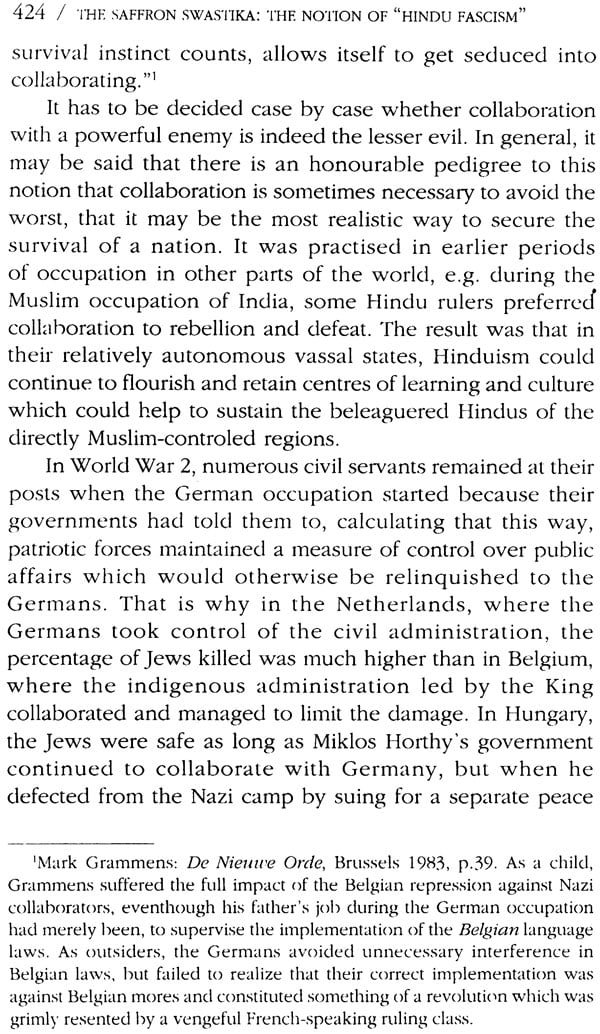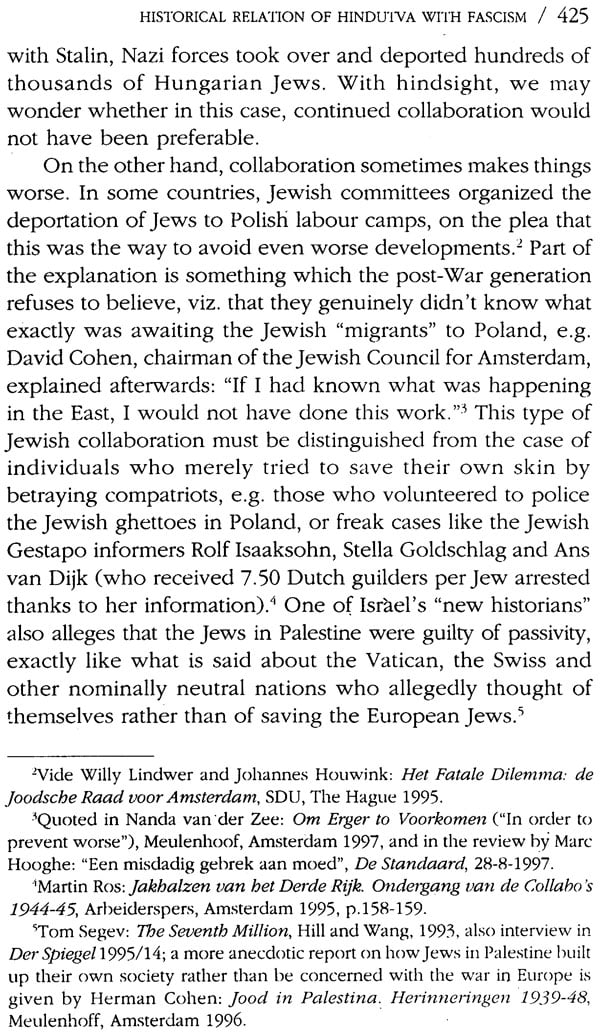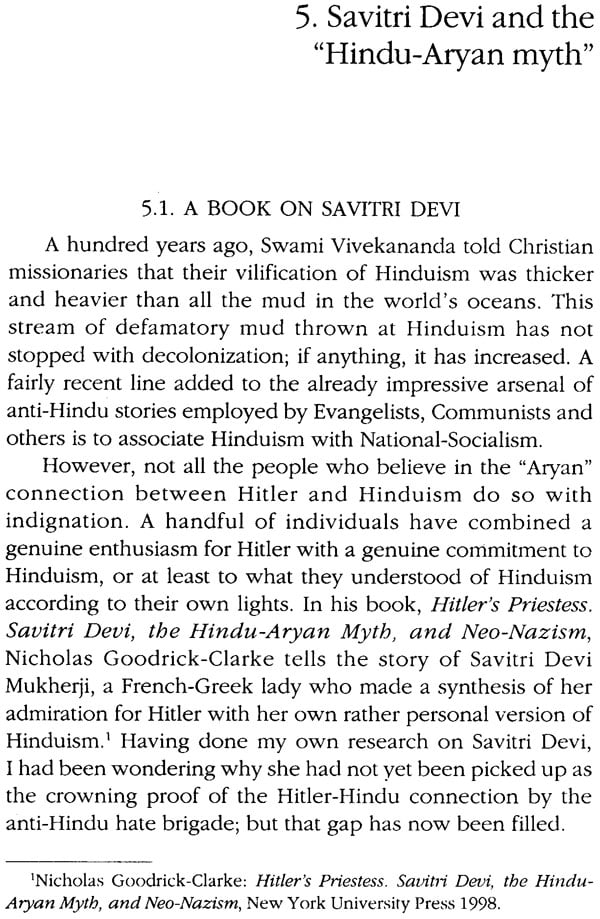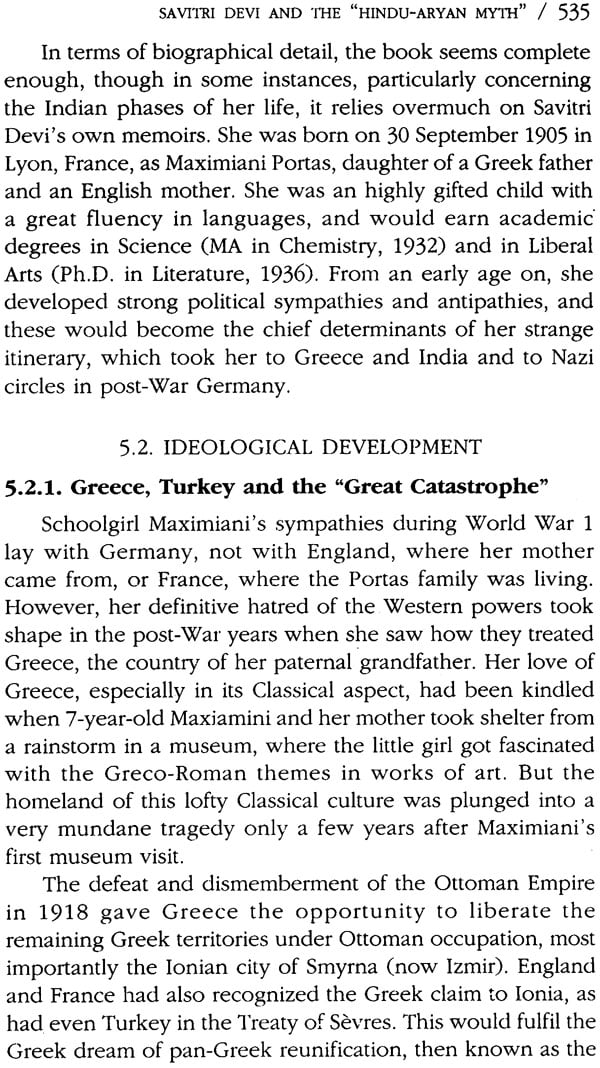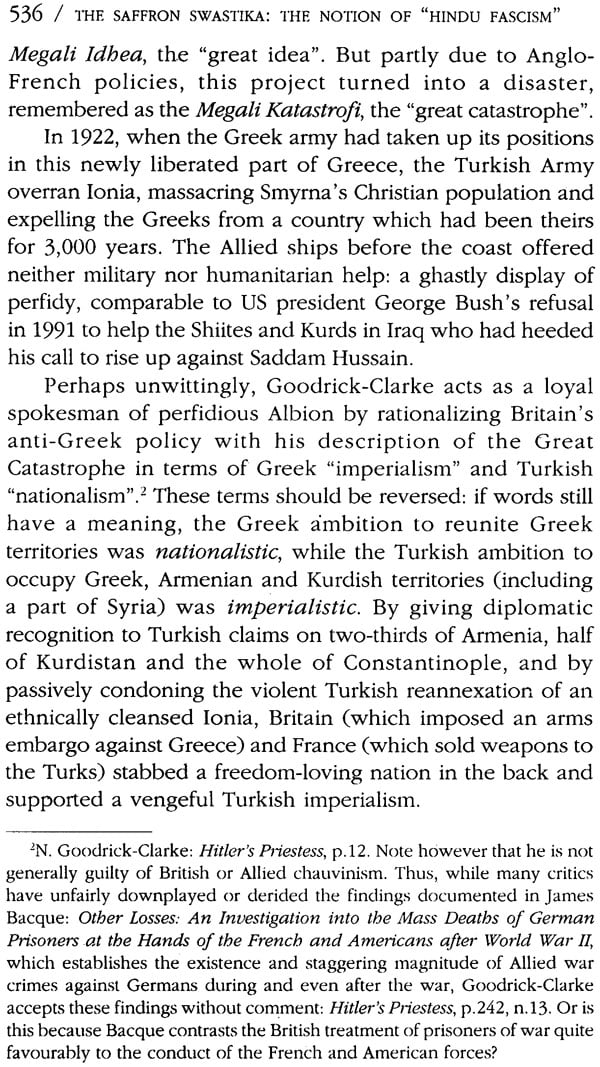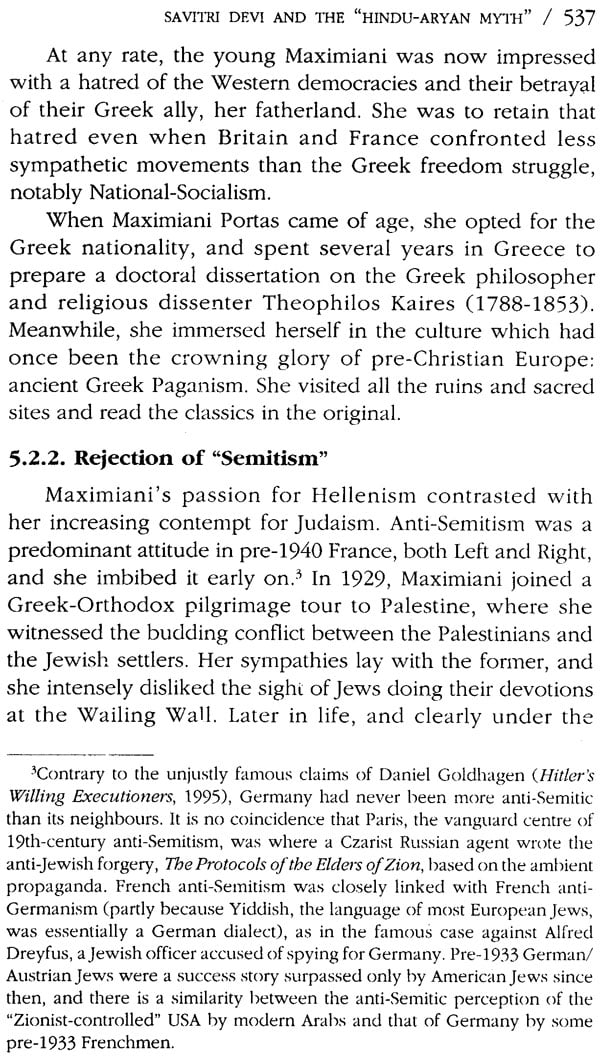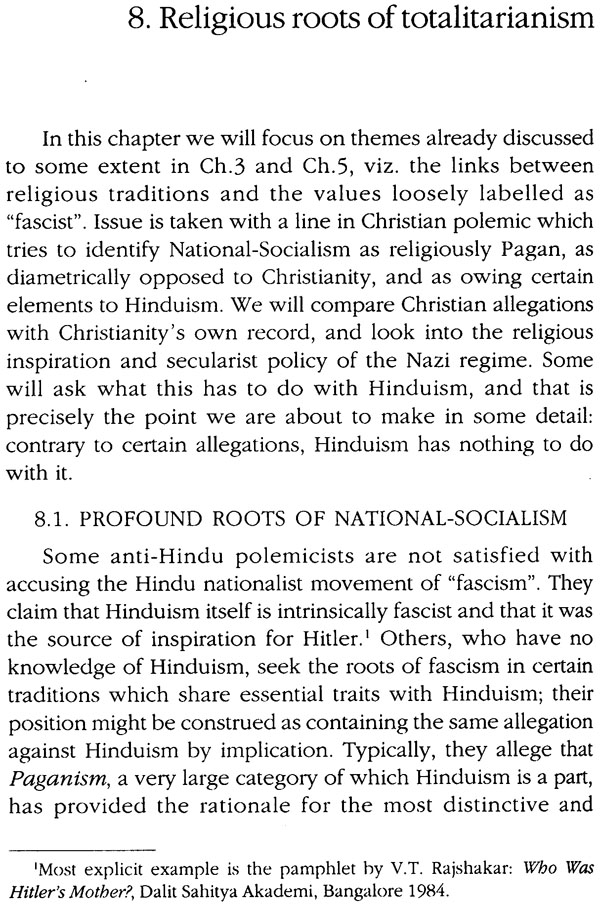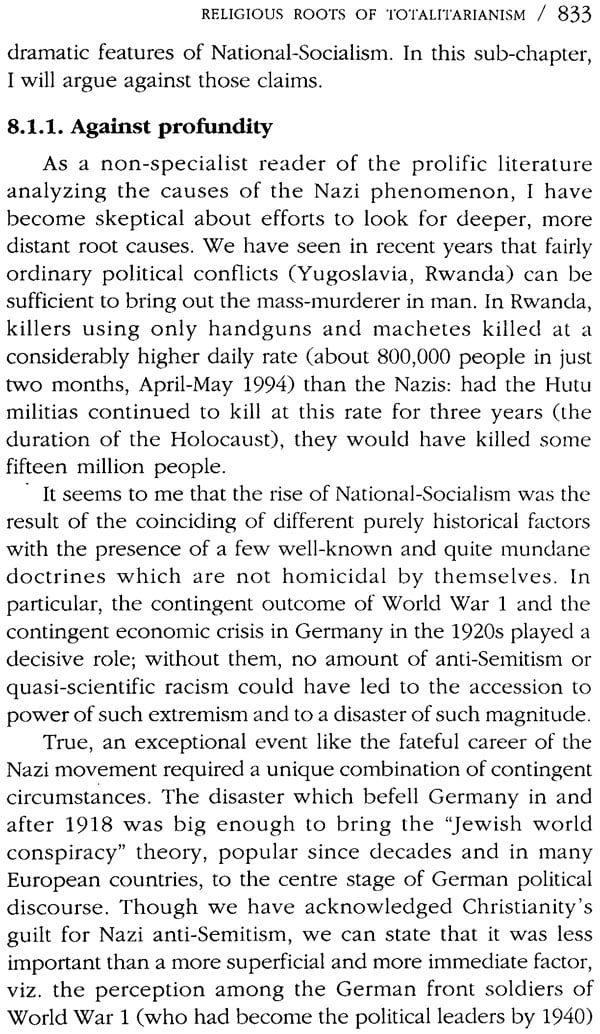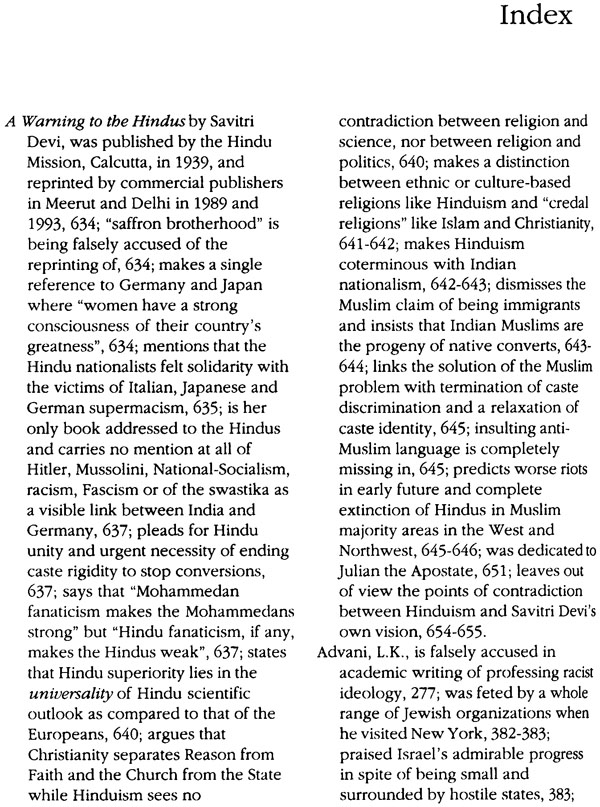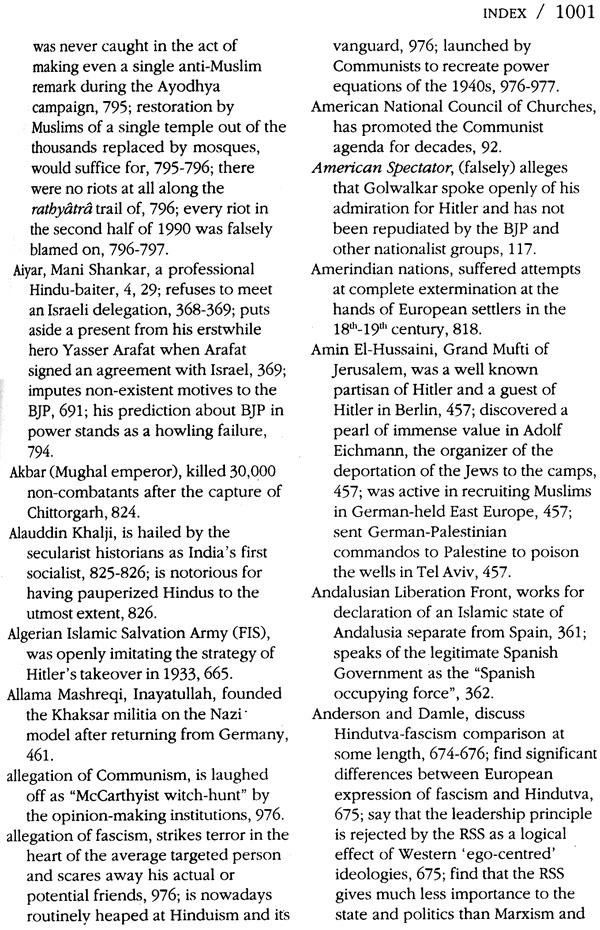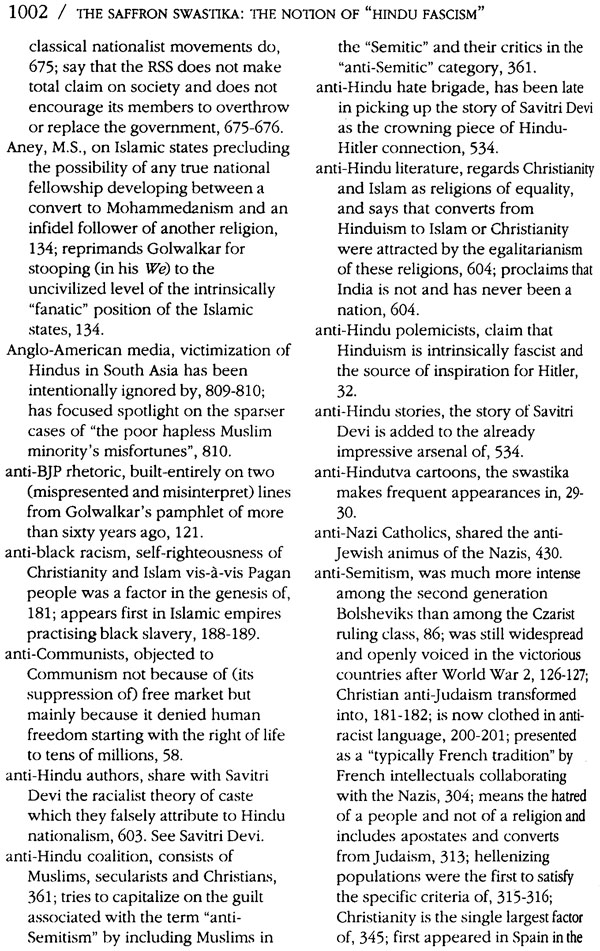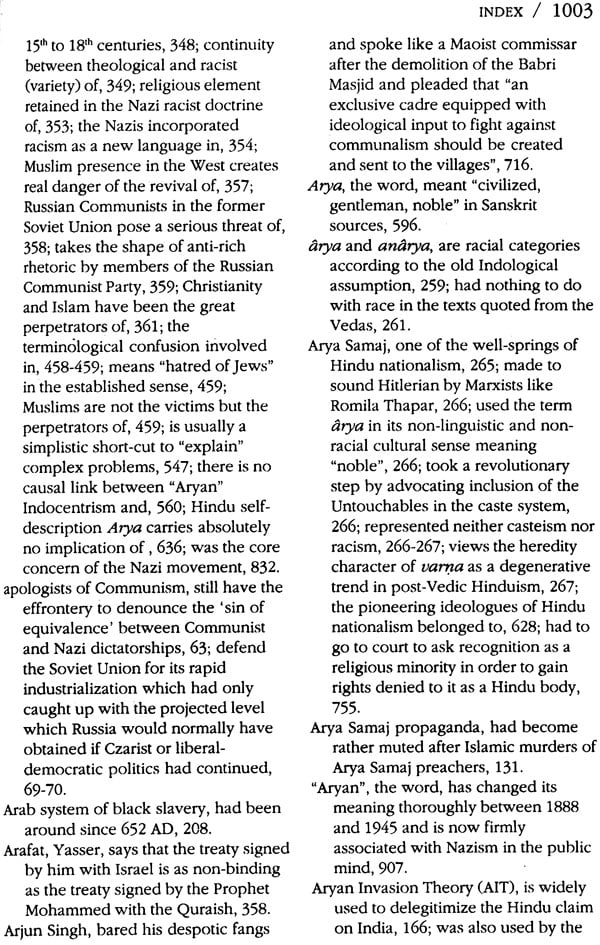
The Saffron Swastika: The Notion of " Hindu Fascism" (Set of Two Volumes)
Book Specification
| Item Code: | NAM819 |
| Author: | Koenraad Elst |
| Publisher: | Voice of India, New Delhi |
| Language: | English |
| Edition: | 2010 |
| ISBN: | 8185990697 |
| Pages: | 1084 |
| Cover: | Paperback |
| Other Details | 8.5 inch X 5.5 inch |
| Weight | 1.40 kg |
Book Description
One of the rare matters on which all known religions seem to agree, is the condemnation of calumny as an extremely grave evil. Calumny carries little risk to the perpetrator but can inflict enormous damage on the targeted individual or group, not through the calumniator's own hands but through those of all who lend credence to his words. It is both cowardly and destructive.
In today's opinion climate, no calumny is worse than the allegation that someone is a "fascist", by which is meant a "Nazi". It is this gravest of calumnies which is nowadays routinely heaped upon Hinduism and its political vanguard. Originally launched by the Communists, the defamatory slogan of "Hindu fascism" has been adopted by Christian and Islamic spokesmen as well as by many Western India- watchers.
It is amazing that adherents of Christianity, Islam and Communism in this country should have the effrontery to hurl this slander on Hindus and Hindu- ism, in their speeches as well as writings. For it is precisely these ideologies which share with Nazism not only their own doctrines of racism, anti-Semitism, exclusivism, totalitarianism and terrorism, but also their own histories of imperialist expansion through crusades, jihads, wars of liberation, genocides, mass slaughters, enslavements and cultural vandalism. They have succeeded in their diabolical game of blackening Hindus and Hinduism to a considerable extent, partly because they have come to dominate the academia and mass media due to the perversion of secularism in the post-Independence Nehruvian establishment but mainly because the Hindu intelligentsia by and large has remained ignorant of the their doctrines and histories and failed to understand the peril posed by the ideological wars they constantly wage on all fronts.
On the other hand, there is nothing either in the time-honoured doctrines or the hoary history of Hinduism which resembles even remotely the ideology or history of Nazism, or for that matter, Christianity or Islam or Communism. Hinduism has always been and remains a deep-rooted tradition of spiritual, cultural and social pluralism with ample provision for all sorts of scepticism and democratic debate. Far from creating any machinery for heresy- hunting and persecution of dissent, Hindus have given shelter to the persecuted people from many lands and in all ages. But what is most important, they have always regarded their own homeland as the only playfield for their chakravartins, and never waged wars of conquest beyond the borders of Bharata-varsha.
Hitler's National-Socialist regime had impressed many people in and outside India because of his real or apparent successes in economics and in national reunification. Yet, the Hindutva ideologues never adopted those ideas of Hitler's which were to give his name the most monstrous connotations. Contrary to an assiduously propagated myth, RSS leader M.S. Golwalkar in his admittedly immature booklet, We: Our Nationhood Defined, did not hold Hitler up as a model for India. Far from it, he explicitly sought guidance from democratic political thinkers, and failed to mention even one of the authoritarian- nationalist leaders and thinkers of the West.
In this book, Dr. Koenraad Elst has presented his wide-ranging study of Fascism, Nazism, Communism and the Hindutva movement. He has drawn the conclusion that "Hindu fascism" like "Loch Ness monster" is merely a combination of words which may produce some sound and fury but which signify no observed reality.
Dr. Koenraad ELST was born in Leuven, Belgium, on 7 August 1959, into a Flemish (i.e. Dutch-speaking Belgian) Catholic family. He graduated in Philosophy, Chinese Studies and Indo-Iranian Studies at the Catholic University of Leuven. During a stay at the Benares Hindu University, he discovered India's communal problem and wrote his first book about the budding Ayodhya conflict. While establishing himself as a columnist for a number of Belgian and Indian papers, he frequently returned to India to study various aspects of its ethno-religio-political configuration and interview Hindu and other leaders and thinkers. His research on the ideological development of Hidnu revivalism earned him his Ph.D. in Leuven in 1998. He has also published about multiculturalism, language policy issues, ancient Chinese history and philosophy, comparative religion, and the Aryan invasion debate.
This book is part of a polemic. So far, the polemical arrows have all been shot from one side, replies from the other side being extremely rare and never more than piecemeal. So, I have taken it upon myself to state the case for the other side. I will argue against the thesis that there exists a substantial and consequential similarity or a common inspiration between the Hindutva movement in India and the authoritarian movements in Europe of the 1930s.
Among academic Hindutva-watchers, it is common to write papers which are in effect polemical, invariably in a hostile sense, and yet to insist on the academic status of such works, a priori shielded from allegations of bias, and available for quotation as arguments of authority to trump objective research findings. In well over half the publications on Hindutva, the most elementary rules of scholarship are thrown to the wind: the uninformed reader may be beguiled by the wealth of footnotes, but when you actually read them, you find that very few of them refer to primary sources. Supposed experts on Hindutva generally make do with a few worn-out or misinterpreted quotations, and the rest of their expertise consists in quoting what the enemies of Hindutva say about their favourite hate object.
As against such publications which are advertised as scholarly though they are polemical, I have tried to write this book according to the rules of scholarship though I don't mind if it is called polemical. To the extent possible, I have tried to go to the primary sources. Already fairly familiar with Hindutva sources, I understood that to compare two movements, one has to have a working knowledge of both, so I have also had to study historical Fascism and National- Socialism and also the contemporary far-Right scene, which has suddenly become much more accessible thanks to the Internet. I am aware that the mere fact of acquainting oneself with those sources is enough to attract dark suspicions nowadays, with academics preferring to sermonize on this topic rather than gathering and analyzing data; but the simple truth is that in studying an ideological movement, there is no way around this elementary stage of fact-finding. This laborious task of studying the authoritarian movements of the interbellum and the history of World War 2, a history discussed (and romanticized) inside out yet so little known among the non-specialists, is only one of the reasons why it has taken me six years to complete the present book. I must thank the publishers for their initial patience as well as for their recent and healthy impatience, for with the material I collected along the way, I could have continued filling pages amounting to several more volumes this size. Concerning the other people to whom I am indebted for their valuable help and support, I believe that for the time being, it is better to withhold their names from a publication as deliberately controversial as the present one.
| Foreword | ix | |
| Chapter 1. | Terms of the Debate | 1 |
| 1.1. | Introduction | 1 |
| 1.2. | On "Fascism" | 15 |
| 1.3. | National-Socialism and "Fascism" | 35 |
| 1.4. | Fascism and Communism | 57 |
| 1.5. | Other Voices | 106 |
| Chapter 2. | Was Guru Golwalkar a Nazi? | 117 |
| 2.1. | Guruji's First Book | 117 |
| 2.2. | The RSS and Ethnic Cleansing | 130 |
| 2.3. | Did Golwalkar Applaud Hitler? | 136 |
| 2.4. | Golwalkar vs Hitler | 151 |
| 2.5. | Conclusion | 167 |
| Chapter 3. | Hindutva, Equality and Racism | 175 |
| 3.1. | A Brief History of Racism | 176 |
| 3.2. | Hinduism, Caste and Race | 243 |
| 3.3. | Hindutva and Racism | 277 |
| 3.4. | Hindus and Jews | 311 |
| 3.5. | Nationalism | 391 |
| Chapter 4. | Historical Relation of Hindutva with Fascism | 423 |
| 4.1. | The Moral Rationale of Collaboration | 423 |
| 4.2. | Hindu and Muslim Positions Regarding Hitler | 455 |
| 4.3. | The Hindutva Involvement in World"War 2 | 466 |
| 4.4. | The Non-Hindutva Forces and the Axis | 503 |
| Chapter 5. | Savitri Devi and the Hindu-Aryan Myth | 534 |
| 5.1. | A Book on Savitri Devi | 534 |
| 5.2. | Ideological Development | 535 |
| 5.3. | Savitri Devi and Hinduism | 561 |
| 5.4. | Savitri Devi and Neo-Nazism | 579 |
| 5.5. | Racism and Caste | 595 |
| 5.6. | Savitri Devi and the Hindu Nationalists | 624 |
| 5.7. | "A Warning to the Hindus" | 633 |
| 5.8. | Savitri Devi' s Religion | 651 |
| 5.9. | Why Bother? | 658 |
| Chapter 6. | Hindutva and Democracy | 661 |
| 6.1. | Alternatives to Democracy | 661 |
| 6.2. | The Shiv Sena and Democracy | 676 |
| 6.3. | The Hindu Nationalist View of Democracy | 683 |
| 6.4. | Is the BJP a Rightist Party? | 696 |
| 6.5. | Threats to Indian Democracy: Where are They? | 712 |
| Chapter 7. | Communal Violence and Propaganda | 720 |
| 7.1. | Lenin, Goebbels, Orwell | 720 |
| 7.2. | Anti-Muslim and Anti-Hindu Propaganda | 726 |
| 7.3. | Propagandistic Use of Communal Violence | 757 |
| 7.4. | Genocide in the Subcontinent | 807 |
| Chapter 8. | Religious Roots of Totalitarianism | 832 |
| 8.l. | Profound Roots of National-Socialism | 832 |
| 8.2. | Hitler, Christianity and Secularism | 863 |
| 8.3. | National-Socialism and Paganism | 887 |
| 8.4. | What About the Swastika Itself? | 929 |
| 8.5. | A Closing Polemic with My Church | 942 |
| Chapter 9. | Conclusion | 976 |
| 9.1. | The Evil of Defamation | 976 |
| 9.2. | Hindutva and Fascism: Historical Non-Relation | 977 |
| 9.3. | But What If? | 981 |
| 9.4. | Hinduism and Fascism: Historical Non-Relation | 982 |
| 9.5. | The Best proof | 986 |
| Bibliography | 988 | |
| Index | 1000 |
